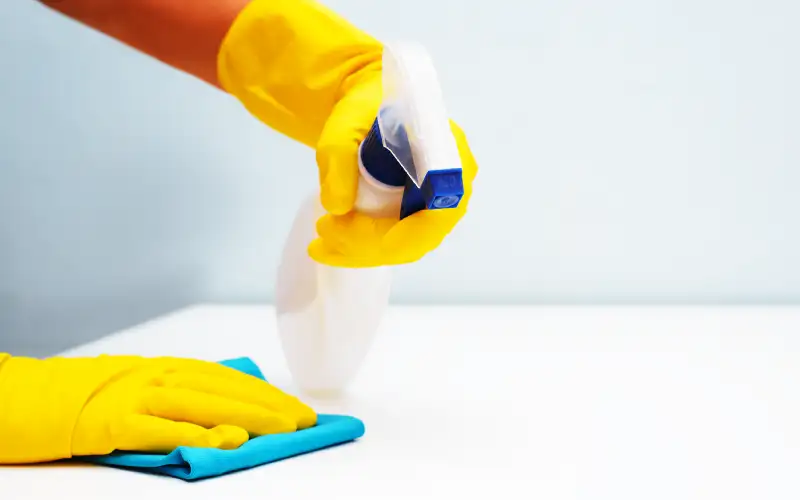How to Maintain Your Cleaning Gloves: The Ultimate Guide
- January 31, 2025
- Fahim
- 4:10 am
When it comes to keeping your home spotless, your cleaning gloves deserve just as much care as your cleaning routine itself.
Proper glove maintenance ensures maximum protection from harsh chemicals and bacteria while also extending the lifespan of your gloves, saving you money in the long run.
This guide breaks down the best practices for cleaning, drying, storing, and inspecting your gloves so they stay in top condition.
Let’s dive in!

Proper Cleaning Techniques
Washing Your Cleaning Gloves
Rinse your gloves immediately after use. Running water removes lingering chemicals and debris.
-
Turn the gloves inside out and wash with mild soap and warm water.
-
Gently scrub both the interior and exterior surfaces to remove all residue.
-
For stubborn stains or odors, apply a water and baking soda mixture as a natural deodorizer.
-
Rinse thoroughly to wash away soap and any remaining particles.
-
Air dry completely to prevent mold or mildew. Avoid direct sunlight, as it can weaken the material over time.
Drying & Conditioning Tips
Drying your gloves properly prevents cracking and keeps them flexible.
-
Gently squeeze out excess water (never wring them out, as this could damage the material).
-
Hang them upside down in a well-ventilated area to allow proper airflow.
-
Keep them away from direct heat sources like radiators or sunlight to prevent material breakdown.
-
Apply a light layer of talcum powder or cornstarch inside the gloves once dry. This prevents sticking and keeps the material soft.
By following these steps, your gloves will stay flexible, comfortable, and ready for action each time you clean.
Storing for Longevity
Best Storage Practices
-
Store in a cool, dry place. High temperatures can weaken glove materials.
-
Keep away from sharp objects to avoid accidental punctures or tears.
-
Use a breathable storage bag or dedicated drawer to protect gloves from dust and debris.
-
Avoid folding or crumpling. Flat storage prevents creases and weak spots from developing.
With proper storage, your gloves will maintain their durability and provide reliable protection for longer.
Avoid These Common Storage Mistakes
-
Storing gloves while damp. Moisture buildup can lead to mold, mildew, and unpleasant odors.
-
Leaving gloves in direct sunlight. UV rays degrade materials over time, making them brittle.
-
Cramming them into tight spaces. This can cause creases, reducing their effectiveness.
-
Storing near strong chemicals. Some chemicals may break down glove material even without direct contact.
A little attention to storage can make a world of difference in glove longevity.
Routine Glove Inspection
How to Identify Wear & Tear
Regular inspection ensures your gloves are still offering the best protection.
-
Check for visible cracks, holes, or thinning areas, especially on the fingertips and palms.
-
Notice any discoloration or stickiness? This may indicate material breakdown.
-
Test elasticity. If gloves feel stiff or loose, they may not fit properly, increasing the risk of slipping off.
When to Replace Your Gloves
If you notice any of the following, it’s time for a new pair:
-
Tears or holes – No longer effective in protecting against chemicals and bacteria.
-
Loss of elasticity – Gloves should fit snugly; loose gloves reduce safety.
-
Persistent odors – If smells linger after washing, the material may be breaking down.
-
Extended use in harsh conditions – Even if they seem fine, heavy usage means they may be weaker than they appear.
Replacing gloves on time ensures maximum protection and efficiency for every cleaning session.
Final Thoughts
Taking care of your cleaning gloves isn’t just about keeping them in good shape—it’s about ensuring your own safety and efficiency while cleaning.
By implementing these simple maintenance techniques, your gloves will last longer, perform better, and provide superior hand protection for all your cleaning needs.
Make Cleaning Safer & More Efficient
Your gloves are your first line of defense against dirt, grime, and harsh chemicals. Keeping them in top condition means better protection and longer use.
“Looking for professional cleaning solutions? Contact us today for a free quote!”
